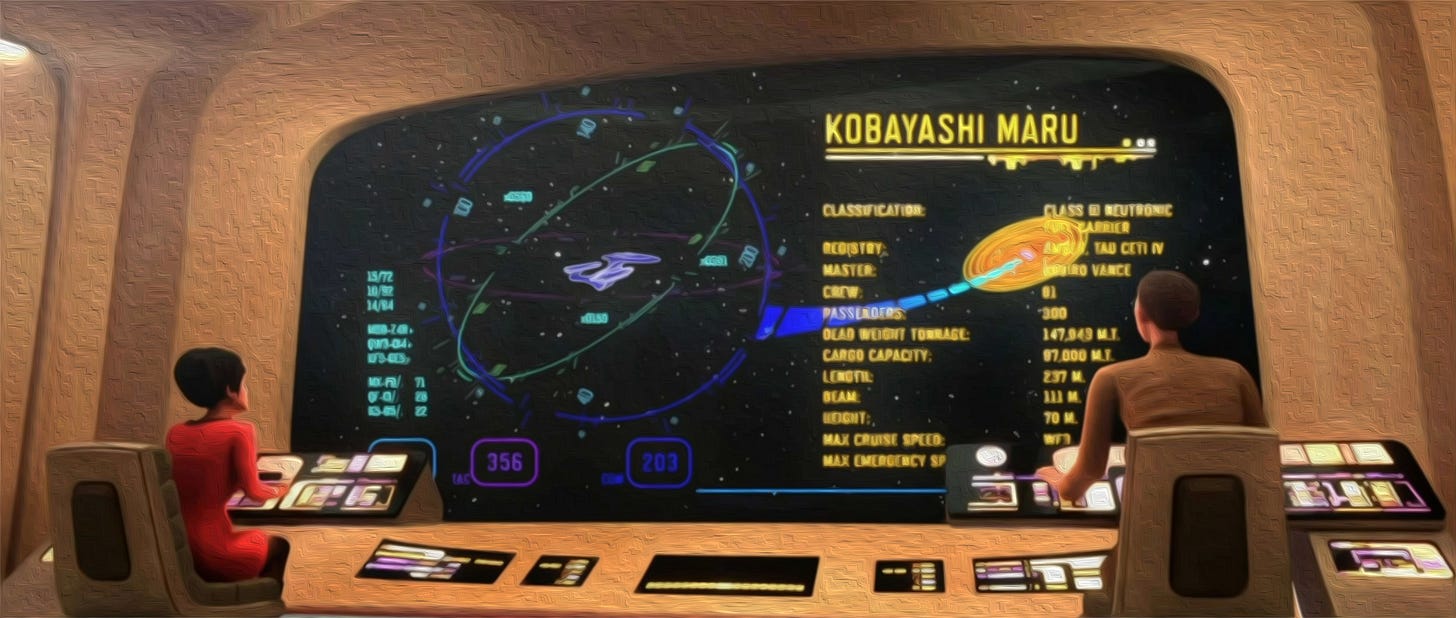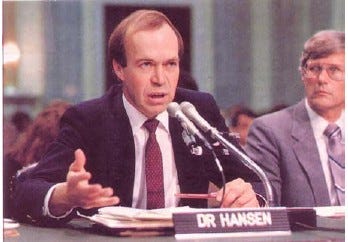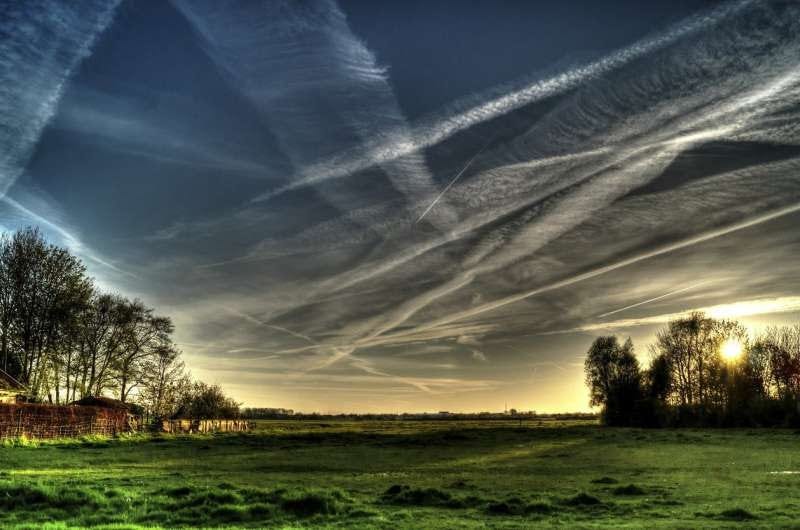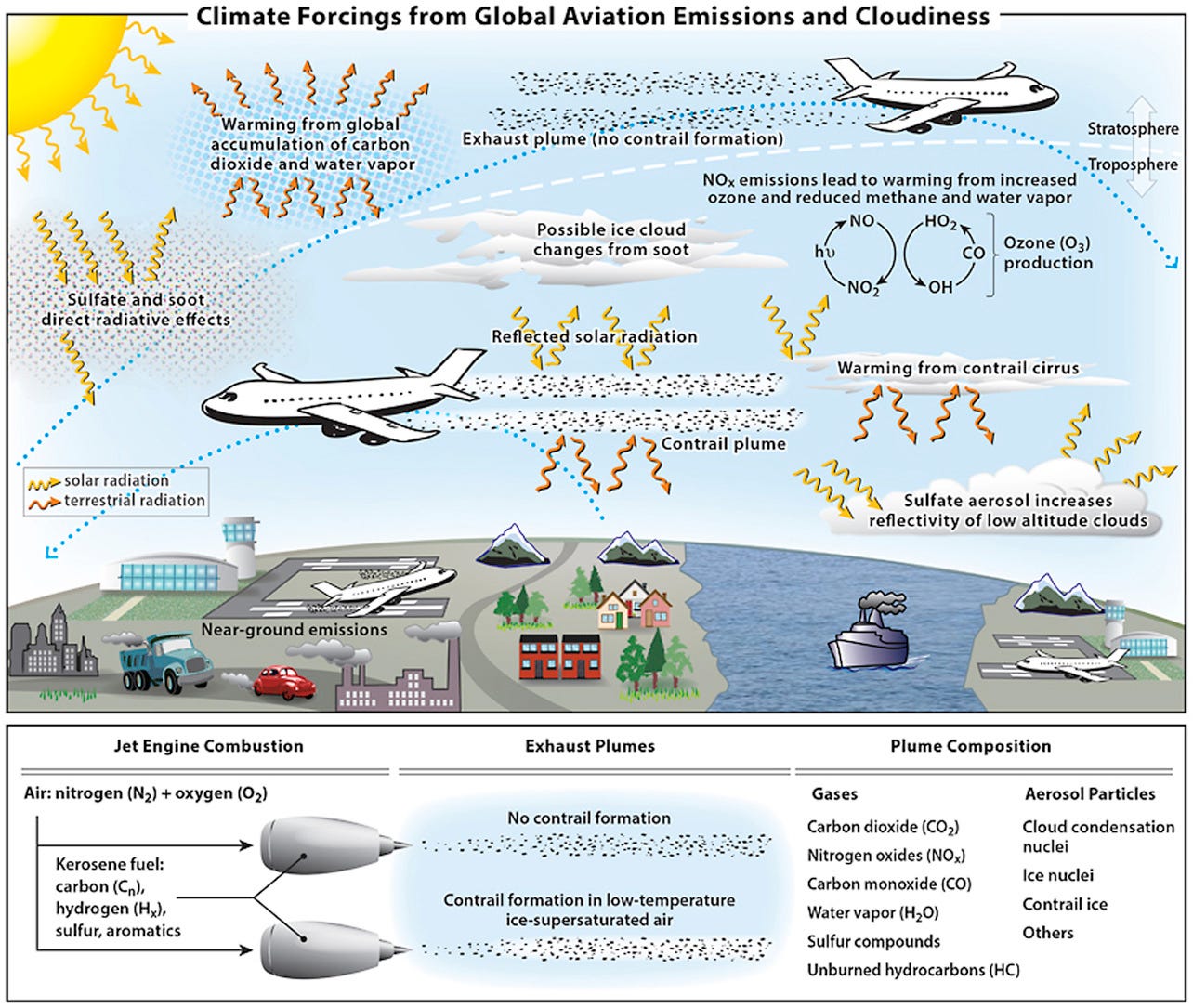Kobayashi Maru Aerosols
No one has solved the McPherson Paradox because it cannot be hacked. The only solution is doing something completely counterintuitive.
In 1970, while I was busy moving into an artist’s loft in Noho, James Hansen was returning to Columbia University, on the upper East Side, from a six-month sabbatical in Holland. He wanted to do post-doc work on the atmosphere of Venus, so he took a fellowship at Goddard Institute for Space Studies—GISS. Climate scientists had known since Tyndall that increasing CO2 levels causes global heating, but Hansen’s work on Venus gave better models and improved empirical evidence.
In 1981, he became the director of GISS and in a paper published in Science, according to Elizabeth Kolbert,
…forecast that the following decade would be unusually warm. (That turned out to be the case.) In the same paper, he predicted that the nineteen-nineties would be warmer still. (That also turned out to be true.) Finally, he forecast that by the end of the twentieth century a global-warming signal would emerge from the “noise” of natural climate variability. (This, too, proved to be correct.)
Later, Hansen became even more specific. In 1990, he bet a roomful of scientists that that year, or one of the following two, would be the warmest on record. (Within nine months, he had won the bet.) In 1991, he predicted that, owing to the eruption of Mt. Pinatubo, in the Philippines, average global temperatures would drop and then, a few years later, recommence their upward climb, which was precisely what happened.
On December 13, 2022, James Hansen and Makiko Sato with 14 co-authors submitted “Global Warming in the Pipeline” to Oxford Open Climate and invited criticism. The paper validated the McPherson Paradox:
Growth of population, agriculture and land clearance produced aerosols as well as CO2. Wood was the principal fuel for cooking and heating. As today, the largest aerosol forcing would be via effects on cloud cover and cloud brightness. This aerosol indirect effect tends to saturate as aerosol amount increases, so aerosol effectiveness per aerosol amount was greatest as civilization developed. Thus, it is unsurprising that human-made global aerosol forcing approximately offset human-made CO2 forcing.…
McPherson retired from his tenured professorship after discovering the paradox for which he is named and went to live in a mud hut in the desert. To quote one anonymous blogger:
If we don’t cut global emissions we all die. But if we do cut global emissions we all die too, but sooner. So humanity needs to solve the McPherson paradox if it’s going to survive. There doesn’t seem to be a solution, but there has to be or we all die. …
It seems to be that humanity can only survive if the vast majority of people do something that doesn’t make any sense… I think I’m going to plagiarize [McPherson’s] statement and create a payload of my own: “At the edge of madness, only laughter remains.”
Contrail Mitigation: Friend or Foe?
Airline contrails have generally been viewed as contributing to the greenhouse effect and therefore to have a positive forcing, or warming effect. According to recent work, contrails may cause a warming effect comparable to an additional 61 percent of total aviation CO2 emissions (629 of 1034 MtCO2e/y). Building off alliances and partnerships to decarbonize aviation, Amory Lovins’ Rocky Mountain Institute (RMI) assembled a cross-sector task force of aviation tech from Alaska Airlines, American Airlines, Southwest Airlines, United Airlines, and Virgin Atlantic, as well as Airbus, Boeing, Flightkeys, Google Research, and Imperial College London to try to do something about it.
Strategies include cleaner burning fuels and optimizing routes and altitudes according to water vapor and temperature. However, sulfate aerosols in engine exhaust increase the reflectivity of low-altitude clouds, thus cleaner fuels would reflect less light back to space and reduce aerosol cooling. Rerouting to avoid contrail formation incurs a fuel cost that might offset the benefit of cooling through greater CO2 and methane emissions.
At 32-42,000 feet, small particles such as soot exhausted by aircraft engines serve as condensation nuclei suitable for water droplet formation. As the particles cool and mix with the surrounding atmosphere, the water droplets freeze into ice crystals, creating contrails. The contrails are short-term clouds but they can also form cirrus clouds that persist much longer. As clouds, they reflect sunlight back into space, reducing the heat of the sun and cooling the planet. Instead of routing planes to produce fewer contrails, perhaps we should be routing them in ways that produce more.
We don’t yet know whether contrails are net heating or net cooling, but the consensus leans towards more heating. A deep dive by an international team of 21 scientists led by D.S. Lee at Manchester Metropolitan University in UK, and D.W. Fahey at NOAA have concluded that “the aerosols and water vapor represent minor contributions” compared to the CO2 and non-CO2 warming effects of air travel.
The same paradox confronts cargo and cruise ships, which are notorious polluters but in recent years have been forced by tougher regulations to burn less sulfurous and soot-producing fuels. As a result, ocean-blanketing aerosols have been in decline, more sunlight has been reaching Earth’s surface, and the top layers of the ocean have been undergoing accelerated heating.
Damned if we do
The time window we have to solve the paradox is shrinking. Hansen’s group concluded that what is in the pipeline was not 2 degrees of warming, or 1.5, but ten. Nearly all of it is masked by aerosols.
The pandemic revealed that these aerosols are sensitive to disturbance. A drop in global cargo ships and commercial air travel in 2020-21 meant lower CO2 emissions but it also reduced stratospheric aerosols, and the latter effect was more significant. Even as fossil emissions declined by more than 5 percent, global temperature went up. The paradox had kicked in.
Hansen and his team say we should have already warmed ten degrees, but seven of those degrees are masked by aerosol cooling, one degree by orbital tilt pushing us toward the next ice age, and one degree by a time delay of a few decades due to mixing of greenhouse gases in the upper ocean layers.
The entire debate at the UN for the past 30 years has been about limiting warming to one or two degrees, knowing that 5 degrees is potentially a human extinction event and 3 degrees may cross tipping points that make 5 degrees unpreventable. Hansen just let us know that 10 degrees is already baked in the cake, just masked by aerosols, orbital cooling, and time lag, mainly from ocean mixing. Moreover, the dimming caused by aerosols is already in decline and will decline more as the world cuts fossil emissions and electrifies with renewables. Doomed if we don’t. Doomed if we do.
I can hear Professor McPherson saying, “I told you so.”
Back in 2009, Hansen told Elizabeth Kolbert,
If we burn all the fossil fuels and put all that CO2 into the atmosphere, we will be sending the planet back to the ice-free state,” Hansen said. “It will take a while to get there—ice sheets don’t melt instantaneously—but that’s what we will be doing. And if you melt all the ice, sea levels will go up two hundred and fifty feet. So you can’t do that without producing a different planet.
Hansen plans a second article soon on the likely acceleration of sea level rise.
In Star Trek II: The Wrath of Kahn, the Kobayashi Maru training exercise was introduced as a simulation designed to test the character of Starfleet Academy cadets in a no-win scenario. Cadet James T. Kirk was famously the only one to ever conquer the exercise. He did it by hacking the sim and changing its rules.
Meanwhile, at Rocky Mountain Institute, they are still trying to find ways to help pilots reduce their contrails. They are not solving the Kobayashi Maru problem. They are ignoring it. That is what humans are best at.
No one has solved the McPherson Paradox because it cannot be hacked. The only solution is doing something completely counterintuitive. What we need to give up to save ourselves is clean tech. We need dirtier tech to save us.
Dirty Home Heating
Compare, for instance, a village powered by a solar-PV farm or small nuclear reactor that removes the carbon footprint of residents plus legacy emissions using direct air capture amide technology. The system is relatively clean (setting aside for the moment, radioactivity) in the sense that it does not emit aerosol pollutants while it supplies the needs of residents for light, heat, coolth, and reversing climate change. Except that it doesn’t… because it's too clean. The absence of aerosols means it is speeding the warming of Earth.

Now suppose we attend to the needs of that same village with one or more pyrolysis reactors powered by agroforestry wastes and sewage. A significant portion of the carbon that was removed from atmosphere by photosynthesis is retained afterwards as biochar, useful in many more products and services. The needs of residents for light, heat, coolth and reversing climate change are still met, but with one major difference. Because the reactor is allowed to return part of its effluent to the sky, aerosol cooling is managed and kept in balance until it can be gradually reduced over time. That is as elegant a hack as any James T. Kirk might devise.
Going back to firewood for heating and cooking may seem like the wrong direction, but it is sustainable into the indefinite future in ways that energy-intensive steel, aluminum and rare earth devices are not. Managed as mixed-age, mixed-species ecologies at a village scale, forests are full employment industries. They make their own replacement parts and clean up their own wastes. They sequester carbon deep in their root zones over millennial time periods. Perhaps most importantly, they make sunlight reflective aerosol clouds.
Here is another example. The search is on for cleaner burning fuels to replace jet fuel, which is similar to kerosene. Ethanol and hydrogen are being tried. The difficulty with ethanol is that it is cleaner than jet fuel and although that may not seem like a problem, if what we want are more clouds, not less, the better choice would likely be hydrogen, whose byproduct of combustion is water vapor, a.k.a. clouds. Instead of trying to find ways to make fewer contrails, perhaps RMI should be trying to make more of them.
The same idea can be applied to ocean-going vessels. Alginate (a natural byproduct of some carbon-dioxide removal technologies) might be buffered with calcium and added to propeller wash to foam it. Leaving a long reflective wake astern would reflect a large fraction of solar energy back to space, especially if deployed early in the day. It would also help to rebalance ocean pH.
History is rife with great examples of successful civilizations that lived within an ecological budget and thrived. People were happy. Children were well-fed. The streams ran clean and clear. What seems at first a great sacrifice will, once there, seem such an obvious choice we will all wonder why we waited. I am not advocating diving over the Seneca Cliff. If we act now, there is still a winding path down that preserves the best of what we have.
We imagine increasing the size of human population to tens of billions. We fantasize glistening cities with autonomous air taxis and personal jet packs powered by clean fusion. If you think people are angry because their Christmas flight on Southwest Airlines got canceled and they still don’t have their luggage back, just imagine how they will feel when they find out that the growth of that SciFi future cannot be realized without the utter destruction of a habitable Earth.
Few will agree with me. Denial of our true situation is strong. Impossible solutions are preferable to the kind of appropriate technologies I advocate. But paradox is a bitch. Hacking the McPherson Paradox, even if it is impossible, is not something we should avoid trying.
Meanwhile, let’s end this war. Towns, villages and cities in Ukraine are being bombed every day. Ecovillages and permaculture farms have organized something like an underground railroad to shelter families fleeing the cities, either on a long-term basis or temporarily, as people wait for the best moments to cross the border to a safer place, or to return to their homes if that becomes possible. There are still 70 sites in Ukraine and 300 around the region. They are calling their project “The Green Road.”
The Green Road is helping these places grow their own food, and raising money to acquire farm machinery and seed, and to erect greenhouses. The opportunity, however, is larger than that. The majority of the migrants are children. This will be the first experience in ecovillage living for most. They will directly experience its wonders, skills, and safety. They may never want to go back. Those that do will carry the seeds within them of the better world they glimpsed through the eyes of a child.
Those wishing to make a tax-deductible gift can do so through Global Village Institute by going to http://PayPal.me/greenroad2022 or by directing donations to greenroad@thefarm.org.
There is more info on the Global Village Institute website at https://www.gvix.org/greenroad
The COVID-19 pandemic destroyed lives, livelihoods, and economies. But it has not slowed climate change, a juggernaut threat to all life, humans included. We had a trial run at emergency problem-solving on a global scale with COVID — and we failed. 6.7 million people, and counting, have died. We ignored well-laid plans to isolate and contact trace early cases; overloaded our ICUs; parked morgue trucks on the streets; incinerated bodies until the smoke obscured our cities as much as the raging wildfires. We set back our children’s education and mental health. We virtualized the work week until few wanted to return to their open-plan cubicle offices. We invented and produced tests and vaccines faster than anyone thought possible but then we hoarded them for the wealthy and denied them to two-thirds of the world, who became the Petri-plates for new variants. SARS jumped from people to dogs and cats to field mice. The modern world took a masterclass in how abysmally, unbelievably, shockingly bad we could fail, despite our amazing science, vast wealth, and singular talents as a species.
Having failed so dramatically, so convincingly, with such breathtaking ineptitude, do we imagine we will now do better with climate? Having demonstrated such extreme disorientation in the face of a few simple strands of RNA, do we imagine we can call upon some magic power that will change all that for planetary-ecosystem-destroying climate change?
As the world emerges into pandemic recovery (maybe), there is growing recognition that we must learn to do better. We must chart a pathway to a new carbon economy that goes beyond zero emissions and runs the industrial carbon cycle backward — taking CO2 from the atmosphere and ocean, turning it into coal and oil, and burying it in the ground. The triple bottom line of this new economy is antifragility, regeneration, and resilience. We must lead by good examples; carrots, not sticks; ecovillages, not carbon indulgences. We must attract a broad swath of people to this work by honoring it, rewarding it, and making it fun. That is our challenge now.
Help me get my blog posted every week. All Patreon donations and Blogger or Substack subscriptions are needed and welcomed. You are how we make this happen. Your contributions are being made to Global Village Institute, a tax-deductible 501(c)(3) charity. PowerUp! donors on Patreon get an autographed book off each first press run. Please help if you can.
#RestorationGeneration
“There are the good tipping points, the tipping points in public consciousness when it comes to addressing this crisis, and I think we are very close to that.”
— Climate Scientist Michael Mann, January 13, 2021.
Want to help make a difference while you shop in the Amazon app, at no extra cost to you? Simply follow the instructions below to select “Global Village Institute” as your charity and activate AmazonSmile in the app. They’ll donate a portion of your eligible purchases to us.
How it works:
1. Open the Amazon app on your phone
2. Select the main menu (=) & tap on “AmazonSmile” within Programs & Features
3. Select “Global Village Institute” as your charity
4. Follow the on-screen instructions to activate AmazonSmile in the mobile app











